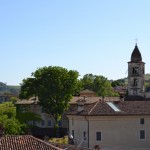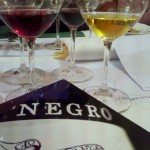Italy’s Piedmont region is full of recognizable names – Michele Chiarlo, Aldo Conterno and Bartolo Mascarello to list just a few. But the area has numerous other producers who, while less well known, are also producing high quality wines. Two such visits that reinforced this view were to Gianpiero Marrone and Negro.
A man blessed with daughters, Giampiero Marrone is at the helm of his family’s winery, with daughters Serena, Denise and Valentina working alongside him. Located in La Morra, the Marrones recently completed a major renovation of their winery building, which has been in the family for four generations. Standing on the new terrace, the 360° views provide a glimpse of 11 different bell towers, which serve as a beautiful backdrop to tasting the wines.
With 18 hectares (~45 acres) planted, the Marrones produce both red and white wines. Their diverse portfolio (they produce 20 different wines) offers some more unique selections such as Favorita, a grape so named for the Queen’s partiality to this wine. This traditional white grape is found only in the Langhe, but it originated from Vermentino when both Piedmont and Sardinia were under Savoy rule. This wine (2011) is light and fresh, well suited as an aperitif, with floral notes, ripe peach fruit and moderate acidity.
Their Langhe Arneis (another local white grape variety) comes from a vineyard selection called “Tre Fie” (three daughters). Redolent of almond, floral and citrus notes, the 2011 wine is rich and mineral on the palate. A blend of Arneis, Sauvignon Blanc and Chardonnay, the Langhe Suris 2010 is quite tropical in aroma, coupled with citrus, along with full body and vibrant acidity. Rounding out the family’s white wine offerings, its Langhe Chardonnay “Memundis” is barrel fermented and spends 15 months on the lees. The 2010 was nicely structured with integrated oak, apple, mineral and a hint of butter and capable of aging for a few years.
Among its reds, the Marrones produce several blends including Passione from a blend of Barbera and Nebbiolo, and Sancarlo, which brings together Nebbiolo, Barbera and Dolcetto. The former was rich and ripe with bright cherry aromas and flavors and freshness on the palate. The latter displayed a dried, jammy fruit character, with cherry, plum and herbal notes and was quite elegant. Serena explained that they prefer Austrian wood for their barrels, which are water bent, but not charred or smoked, and choose a smaller size to speed the aging process.
Conversely, their Barolo “Pichemej” is aged in traditional, large oak casks. The 2008 was still extremely tight, but exhibited nice floral, cherry and spice aromas and flavors. It needs time in the cellar for the tannins to soften. We closed out the visit with their Barolo Chinato. This is a traditional aromatized wine, flavored with spices, cinchona (quinine), rhubarb roots and gentian, making it equally perfect as a digestif or as an accompaniment to dessert. The medium sweet palate offered spices, cocoa and stewed fruit, yet finished quite cleanly.
Situated to the north of Barolo, the Roero DOCG features Arneis and Nebbiolo. While this denomination hasn’t garnered the attention that Barolo and Barbaresco have attained, the area produces extremely high quality wines, particularly with the whites. Here, the Arneis grape thrives in the marine-fossil rich soils that maintain high acidity in the grapes.
Within Roero, the Negro family has been producing wine for generations. Their Perdaudin estate dates to 1670 as evidenced in the local archives. The current generations include Giovanni and Marisa Negro and their children, Emanuela, Gabriele, Angelo and Giuseppe, making the winery a true family affair. Recognizing the need to sustain the land for future generations, the family has shifted its vineyard cultivation from the use of chemical fertilizers to organic compost.
Championing the aging potential of Arneis, the Negro family presented a vertical tasting of their Arneis wines. The 2001 Roero Arneis 7 Anni proved the point, showing some development, while retaining crisp acidity, minerality and a creamy texture. Surprisingly, the 2007 Roero Arneis “Perdaudin” actually seemed older with its slight oxidative character of nuts and bruised apples.
The Negro’s Roero Sudisfà Riserva provided proof as to the quality of the Roero Rosso (red) wines. These were quite elegant, despite the tannic nature of the wines. The 2004 and 2006 particularly showed well, with the 2004 offering dried flowers, balsamic vinegar and plums on the nose, with dried fruit and meatiness on the palate. Overall, it showed richer, darker fruit than the 2006, which displayed similar floral character, but was joined by brighter strawberry aromas and flavors.
Like the Marrones, the Negros have a significant range of wines. Their two Metodo Classico sparkling wines include the Giovanni Negro Roero Arneis Extra Brut and the Maria Elisa Rosé Brut, produced from Nebbiolo, while the two dessert style wines include Birbet, an off-dry wine made from Brachetto (but unlike Brachetto d’Acqui, this isn’t a sparkling wine), and Passito, a medium sweet wine made from Arneis grapes that have been dried to reduce water content and concentrate flavors.
These two visits reinforced the need to look beyond the usual suspects and to explore the broader world of Piedmont wine.



Hi Tracy, so nice to see the story of the Marrone’s here. I was with you on that visit and now while reading what you wrote it reminded me of how interesting were the wines and how pleasent was that visit! Do you recall the fruits, the cheeses and the nice talk we had? Suh a good time. Thanks for that!
Silvia – from Brazil
Hi Silvia,
Lovely to hear from you and glad you enjoyed the story. It was nice to have experienced the visit with you and delighted that I could rekindle such fond memories for you.
Best wishes,
Tracy